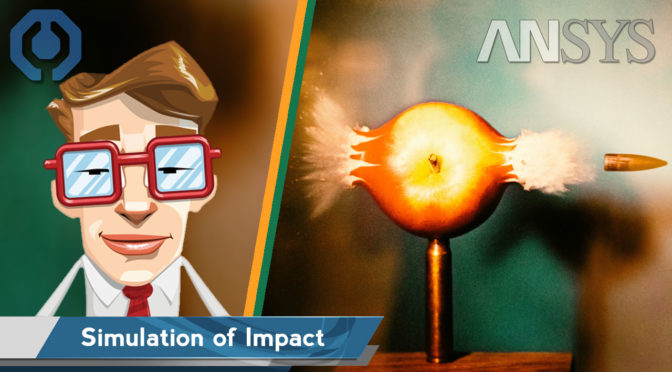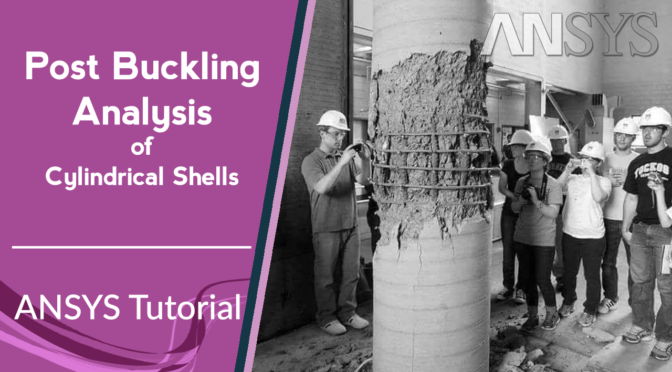✍️ In this tutorial, we will learn how to do a simulation of the Impact using ANSYS Explicit Dynamics. We use nonlinear materials for impact analysis. Through this tutorial, we will simulate the impact of a bullet on a steel wall. The dimensions of the model are chosen based on a calibre 22 bullet. We will find out about the steel wall resistance to the fired bullet, which hits it at a speed of 900 meters per second in a perpendicular direction.
Post Buckling Analysis of Cylindrical Shells – ANSYS Tutorial
In this video tutorial, we will learn about performing post buckling analysis of cylindrical shells under hydrostatic pressure in ANSYS Workbench. Also, we will see how to create pre buckled model of the cylindrical shell with the desired buckling mode and deformation scale factor for use in the post-buckling analysis. Cylindrical shells can fail due to compression in the longitudinal or circumferential direction, or due to shear. But usually, due to all of those effects combined in one way or another. Plus, this can happen locally or globally.
Step by step Transient Thermal Analysis – Cooling of molten Aluminum
Transient thermal analysis is an important procedure to determine the thermal behavior of a system in a specific period of time. In phase transition of molding process or in electronic parts simulations it is essential to consider the timely behavior of temperature changes. Using ANSYS transient thermal module we can evaluate complex systems in a fast and efficient way. In this video tutorial, the molten aluminum is entered into the mold at 800°C while the temperature of the mold is initially at 30°C.
Multi-Objective Optimization of Composites using ACP & Mechanical
In this tutorial, the step by step procedure of multi-objective optimization of composites by ANSYS composite PrepPost (ACP) and the mechanical module is described. Finding the best method for arranging the thickness and angle of composite layers is always very challenging and can be time-consuming. With the help of ANSYS composite PrepPost, optimization methods, and an ANSYS specialist, this procedure can be done much easier and faster than experimental methods.
Design of a composite joint in Ansys Composite PrepPost (ACP)
In this video tutorial, we are going to model a composite joint using Ansys Composite PrepPost with full details. It demonstrates an assembly modeling approach in ACP and highlights the strengths of the oriented element sets. T-Joints are typical connections in composite constructions. They are used to connect two parts at right angles.
Sandwich composite analysis in ACP | ANSYS Tutorial
✍️ In this video, we are going to design and analyze a sandwich composite panel using ANSYS Composite PrepPost (ACP). We will go through the complete process of modelling, solving & post-processing. A sandwich composite panel is any structure made of three layers: a low-density core, and a thin skin-layer bonded to each side. Sandwich panels are used in applications where a combination of high structural rigidity and low weight is required.
Woven Composites design | ANSYS Tutorial
✍️ In this tutorial we are going to learn about ANSYS Material Designer environment and its abilities. We will see how to design unidirectional and woven composites in ANSYS Material Designer and extract their homogenized material properties. Composite materials consist of two or more layered or otherwise integrated materials to create a new material with different material properties. These materials combine the best properties of their component materials, resulting in a product that is both light and strong.
Impact Simulation of an Asteroid | ANSYS Tutorial
✍️ How can we simulate an asteroid impact with earth? Ansys explicit dynamics gives us a strong and robust tool to see the effects of such a phenomenon through impact simulation. In mechanical science, an impact is a high force or shock applied over a short period when two or more bodies collide. Every year we are hearing that a dangerous asteroid is approaching earth. These asteroids or planetoids are minor planets of the inner Solar System which can be very big and usually travelling with very high speeds.
⭐ Creep Analysis | ANSYS Tutorial ⭐
✍️ In this tutorial, we are going to use ANSYS Workbench to simulate the creep deformation of an Aluminum Alloy (6061-T6) under constant stress and temperature. We will learn about the simulation of a Creep process in ANSYS Mechanical and analysis settings for Creep. For creep analysis, we will use Norton’s power law equation, which is the most important and widely used constitutive equation to predict the secondary Creep. We will see how to adjust the define material properties and settings of creep analysis in the static structural environment like creep effects, load steps, initial conditions, Creep Limit Ratio and Creep Strain Ratio.









